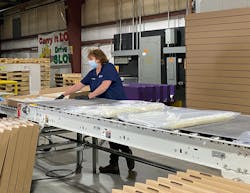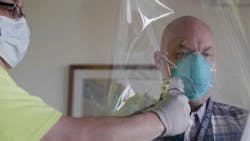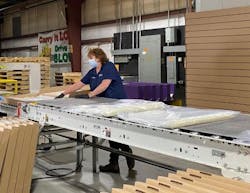Case Study: Manufacturer FLEXcon pivots processes during the COVID pandemic
By Lavon R. Winkler, FLEXcon North America CEO
The impact of COVID-19 has required many companies to re-think both product and process. Perhaps you are one of them.
Even essential businesses such as ours—FLEXcon—have seen a stark decline in demand for some market segments and spikes for others. Companies that have been able to pivot their focus to develop urgently needed products are finding success despite an unstable economy.
The shortage of adequate PPE for medical workers is one example. FLEXcon found itself uniquely positioned with the necessary equipment and manpower to quickly create solutions to address gaps in supply.
Here…a quick case study:
Frontline healthcare workers must continually wear N95 masks which require proper fitting to protect the wearer from airborne pathogens. Test kits used for this purpose come with reusable hoods. Due to
The FLEXcon test hood in action
COVID-19, however, some healthcare workers are uncomfortable utilizing a test hood that others have worn. One local hospital searched for replacement hoods, only to find availability scarce and prices steeply increased. This hospital reached out to FLEXcon to develop a solution that would alleviate employee concerns—an affordable, single-use test hood that would be compatible with respiratory fit-test kits currently on the market.
Flexibility and responsiveness are key
This is where flexibility and the ability to quickly problem-solve can set companies apart. Existing expertise within the workforce can be harnessed to develop products that meet the need and map out processes to produce them efficiently. Readily available manufacturing equipment, perhaps with minor modifications, can be utilized.
In this case, our engineers created a disposable test-hood prototype in less than 24 hours, after which they worked with hospital representatives to tweak the design, such as moving the location of the hole in which to place a nebulizer. Once the design was finalized, they crafted special tooling for an adhesive coater to accurately zone-coat where sealing was required. A standard process was established, assembly areas were identified, and team members were sourced to ramp up production.
The fit-test hood includes front and rear panels coated with pressure-sensitive adhesive along the left, right and top edges. An aperture is created in the front panel through which test substances are introduced into the interior cavity. During fabrication, shoulder pieces are cut off the front and rear panels to give the bottom edges a generally truncated V-shape. A portion of each shaped-bottom edge rests on the test subject’s shoulders. The hood is able to remain upright because of the thickness of the film used and the presence of the strips of pressure-sensitive adhesive.
Prepping the test hoods for shipment
It’s important to note that having a design does not necessarily mean an item can be produced on a large scale. Time studies should be conducted to understand the cycle times of each step in the process so refinements can be made. The data can be used to facilitate the assignment of adequate staffing to meet takt time as demand increases. To that end, companies with cross-trained workers who are well-versed in the practice of standardized work can easily re-deploy resources as situations develop and production needs change; having such training in place as an ongoing manner of operation is essential.
Challenging the status quo
In these unprecedented times, it is necessary to challenge everything—our assumptions, our ways of doing things, the services we provide and the products we make. In adversity lies opportunity, and the willingness to think innovatively and work collaboratively with all stakeholders is what can mean the difference between companies that persevere and those that succumb.


